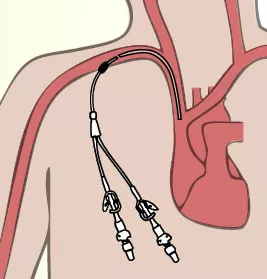Long Term Intravenous Catheters

There are two types of long term intravenous catheters that are surgically placed in patients who need to receive intravenous infusions of medication, blood products or nutrition or who may require frequent blood sampling. Compared to the intravenous catheters placed in the arm or hand, these catheters are designed to stay in longer and may be more comfortable. These are called central venous catheters because they are inserted into a large vein leading to the heart. The type of catheter required will be recommended by your child's physician. Listed below are the two types of catheters and a brief description of each.
External catheter (Broviac® or Hickman® catheter)
This is a soft, flexible tube which is tunneled under the skin of the chest and inserted into a large vein near the heart. These catheters have a single or double tube or "lumen". The number of lumens needed will be determined by your child's physician.
Each tunneled catheter has a "cuff" wrapped around the tubing that is placed under the skin. This cuff helps to keep the catheter in place as well as provide a barrier to infection. You may feel a bump under the skin where the cuff is located.
Tunneled catheters can eliminate the need for needle sticks and assure ready access to the blood stream. They require daily care, some home nursing support and restricted bathing and swimming. The tubing can become plugged and is a potential source for infection.
Totally implanted catheter (Portacath® or Mediport®)
A portacath or "port" is comprised of two components, a self sealing injection port and a catheter attached to it that enters the vein. The port and catheter are placed entirely under the skin using a small incision. There will be bump on the chest wall where the injection port is located. This is the site where the access needle is placed.
Ports assure ready access to the blood stream with no daily home care or restriction of bathing or swimming. They require monthly access and flushing to prevent plugging, if not in use for other purposes. They are accessed through the skin with a special needle. Just as with tunneled catheters, ports can become plugged and are a possible source of infection. There is also the risk of misplaced injection into the skin near the port.
How is a central venous catheter placed?
An external tunneled catheter is inserted, by a pediatric surgeon, in the operating room under general anesthesia. A small incision is made on the right or left side of the chest or neck to insert the catheter into the vein. The catheter is then tunneled under the skin to an exit site on the chest. The exact site will be determined by the surgeon based on what is best for your child. At the exit site, there may be small stitches placed around the catheter securing the tubing to the skin to keep it from coming out. These stitches can be left in place until they break loose from the skin, usually by two to four weeks.
There will be a small dressing over the insertion site on the upper chest or neck which may be removed in two days and a dressing over the catheter exit site that is to be changed the day after insertion. The nurses will teach you how to do this and instruct you in the frequency of dressing changes to be done at home.
A port is placed in the same fashion as a tunneled catheter. However, there is no exit site because the catheter is placed completely under the skin. There is an incision located just above or below the injection port. There will be small dressings over the insertion site and one near the injection port. Your child may leave the operating room with a needle inserted in the port and taped in place for immediate use of the port.
How will I care for my child's catheter?
Your child's nurses will teach you how to care for the catheter or port while your child is in the hospital. They will also arrange for home nursing care and supplies if needed once your child is discharged home.
How will the catheter be removed?
You will be referred to the Pediatric Surgery office when it is time to schedule catheter removal. This is a short out patient procedure performed under anesthesia.
External catheter removal
External catheter removal is usually performed under anesthesia on an outpatient basis. In most patients both the catheter and the cuff are easily removed. In some cases, the cuff remains firmly under the skin and only the catheter can be pulled out. This cuff does not usually cause a problem and can remain under the skin permanently. Removal of the cuff requires a separate skin incision and therefore this is not generally done. Prior to catheter removal, please feel free to ask your child's surgeon any questions you may have about the procedure.
Totally implantable catheter removal
Removal of an implanted catheter is also done under anesthesia as an outpatient. Both the catheter and the injection port are removed through the same small incision used for implantation. Prior to catheter removal, please feel free to ask your child's surgeon any questions you may have about the procedure.
Care of the incision postoperatively
If there is a gauze and plastic dressing over the incision, it may be removed two days after the operation. If there is a piece of white tape over the incision, it may come loose and fall off by itself. If this does not happen, it may be removed one week after the operation. Your child may bathe, shower or swim two days after the operation, if he or she feels well enough. If you have any questions about your child's recover, please contact the Pediatric Surgery office at 415-476-2538. If you notice redness, tenderness, swelling or discharge of the incision call Pediatric Surgical office immediately.
